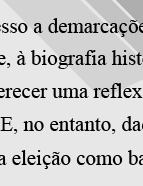

................................
A significant and relevant part of biographical production from the third quarter of the century converged in this model – or in the variations composed upon it. However, diverse biographical forms, even within the restricted academic environment, continued and continue to coexist. Generally more practical than reflective, the life portrait has never been confined to a defined territory, nor tied to a particular way of writing history. It may have been a preferred genre among those with a more traditionalist view of the past, which included the collaborators of the re-established APH and the heirs of the distant historian-clergyman. But among its most illustrious representatives, such as Queirós Veloso, Banha de Andrade, Armando Cortesão, Teixeira da Mota, Virgínia Rau, Avelino de Jesus da Costa, Veríssimo Serrão, and Oliveira Marques, the place they occupied was markedly disparate, be it in theoretical, institutional, or ideological terms. What unites them, from a distance, is their undeniable interest in recording singular trajectories, reflected in a considerable volume of biographical texts. Yet, it must be said that biographical writing did not establish itself as a significant trend in Portuguese academic circles. It always depended more on personal research interests than on any theoretical or other principle that would determine its inclusion in a cohesive historiographical body. Perhaps this, above all, has earned it the epithet attributed by the more recent historiography of "marginalised," if not "forgotten". However, the prominence it enjoys today, anchored in a fast-growing production of works, does not necessarily have to be celebratory. The elegy has long been declared a distant relative of history. In order for the discourse on historical biography not to follow the same fate and finally become both practice and reflection, a detailed portrayal still needs to be traced.
